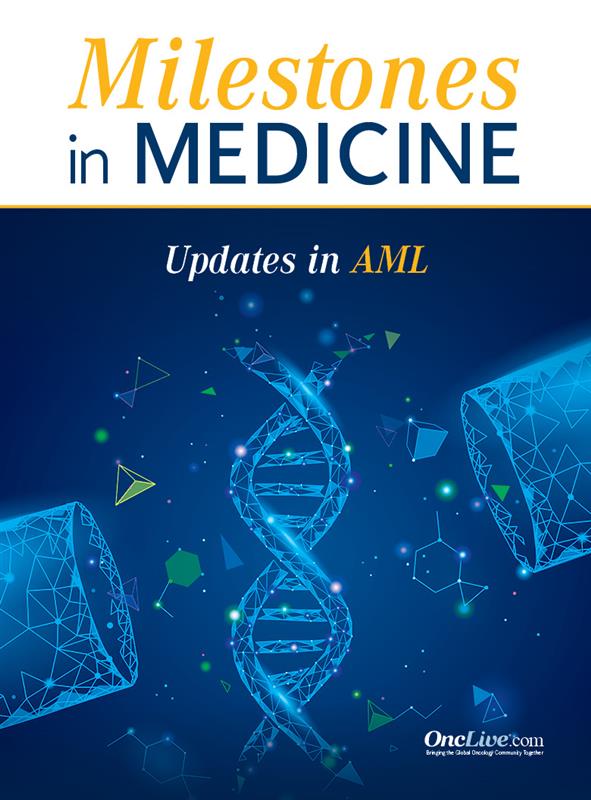Publication
Article
Unique Properties of Uproleselan Demonstrates Promise in AML
Author(s):
Eunice Wang, MD, highlights the mechanism of action of E-selectin inhibitors and speaks on the safety profile and efficacy of uproleselan in patients with acute myeloid leukemia.
Eunice Wang, MD

The addition of an E-selectin inhibitor such as uproleselan (GMI-1271) to chemotherapy may improve outcomes for patients with acute myeloid leukemia (AML), largely due to the agent’s unique mechanism of action, according to Eunice Wang, MD.
Findings from a phase 1/2 trial (NCT02306291) which investigated the safety, antileukemic activity, and efficacy of uproleselan, a novel E-selectin inhibitor, in combination with mitoxantrone, etoposide, and cytarabine chemotherapy demonstrated promising results among patients with AML. Those in the relapsed/refractory AML cohort (n = 66) experienced an overall response rate (ORR) of 39%, including a 33% complete response (CR) rate. Patients with newly diagnosed AML (n = 25) experienced an ORR of 72% with a 52% CR rate.
Additionally, uproleselan elicited minimal residual disease (MRD) negativity rate of 69% in the relapsed/refractory arm and 56% in the newly diagnosed arm. At a median follow-up of 9.7 months, the median overall survival (OS) was 8.8 months (95% CI, 5.7-11.4) and 12.6 months (95% CI, 9.9-not reached) for relapsed/refractory patients who received the recommended phase 2 dose of uproleselan (10 mg/kg; n = 54) and newly diagnosed patients, respectively.
“There’s a lot of interest in adding uproleselan as well as other E-selectin inhibitors to standard chemotherapy with the theory that it would lead to higher overall responses and higher rates of leukemic cell death, which could translate into prolonged survival in patients with AML,” Wang explained.
In an interview with OncologyLive®, Wang, the chief of Leukemia Service and the medical director of Infusion Services at Roswell Park Comprehensive Cancer Center in Buffalo, New York, highlighted the mechanism of action of E-selectin inhibitors and spoke on the safety profile and efficacy of uproleselan.
What are some of the benefits of MRD testing as investigators continue to learn more about what it means for patients with AML?
For the treatment of patients with other hematologic malignancies including chronic lymphocytic leukemia, acute lymphocytic leukemia, even multiple myeloma, one of the key markers of the success of any treatment modality is the ability to obtain the deepest response. MRD is a reflection of the last remaining cancer cells below the level of detection that we can see by eye in the bone marrow or in the blood. MRD is rapidly becoming something of great interest for the treatment of patients with AML based on its success and significance in, other blood cancers. Right now, we are using either molecular, detection of specific mutations, or abnormal protein markers via multiparameter flow cytometry to measure MRD in our patients with AML.
The difficulty has been that although we know that MRD negativity is important we don't always know how to measure it in all of our patients with AML.
AML is an incredibly biologically diverse disease, with many different mutations, many of them only found in 5% or 10% of patients. Also, the protein expression of the myeloid cells is incredibly diverse, it can [follow approximately] 9 different differentiation pathways. [Therefore] coming up with the standardized MRD test for AML has been very challenging. We have been looking at validating these tests to come up with a way to utilize it across the board for all clinicians that treat AML. That is still work in progress.
What is the potential of E-selectin as a viable treatment target in AML?
E-selectin, or endothelial cell adhesion molecule, is a key component of the bone marrow microenvironment. There are areas in the bone marrow called stem cell niches where both normal hematopoietic as well as leukemic stem cells reside, and they adhere to that bone marrow microenvironment through molecules such as E-selectin and [other] similar compounds.
When leukemia cells or leukemic stem cells are bound to their microenvironment, they're much less available [to be] exposed to chemotherapy and acquire what we call a niche- or microenvironment-induced chemotherapy resistance. Leukemia cells floating in the bone marrow aspirate or the peripheral blood are exposed to high levels of chemotherapy and are radically destroyed, but when stuck in the bone marrow to their niches, are much harder to eradicate. This has led to a whole area of research into blocking the E-selectin. These inhibitors, [such as] uproleselan, dislodge those leukemic stem cells from their protective homes and allow them to become exposed to chemotherapy.
What is the potential to combine uproleselan and other E-selectin inhibitors with chemotherapy or other standard therapies?
The unique mechanism of action of E-selectin [potentially] could allow us to sensitize [tumor] cells to chemotherapy, not only conventional chemotherapy with agents such as cytarabine, daunorubicin, or idarubicin, but to other targeted therapies such as venetoclax [Venclexta] and isocytodine. The data and the role of E-selectin in mediating responses to those other therapies is a little bit less well established, but certainly the underlying mechanism of action could still be relevant for those agents.
The other theory is that by freeing up these leukemic cells from their bone marrow microenvironment and making them more available in the peripheral blood, could you also make them more accessible or more recognizable potentially by elements of the immune system. We know that chimeric antigen receptor T-cell therapy or immune cell therapy occurs on a cellular level and involves individual T cells or B cells being able to recognize, activate, and destroy individual cancer cells. Even macrophages or dendritic cells are reliant on that cell-to-cell recognition and activation. Could E-selectin administration free up a bunch of those leukemic cells and make them more accessible to immunotherapies as well as targeted therapies and standard therapies?
For example, FLT3 inhibitors are more effective in cells that are not stuck in the microenvironment. There's data showing that when you prevent or release that microenvironment chemotherapy resistance then the FLT3 inhibitors work much better.
Could we be seeing the same thing with these E-selectin inhibitors? The data will need to be established in a prospective way. We’re very much looking forward to phase 3 trials of uproleselan as an agent added to both newly diagnosed and relapsed refractory patients to see whether this could, in a nontoxic way, improve response rates. There’s early data from a phase 1 trial showing response rates of [approximately] 70% and prolonged OS for over a year in newly diagnosed AML patients, some of whom had a poor prognosis otherwise. [This is] definitely an area of further active investigation in the field.
What has been seen in terms of the safety profile of uproleselan plus chemotherapy?
As of now we haven't seen any specific on target toxicity; some of the agents that we treat AML with have the expected toxicities of nausea, vomiting, diarrhea, severe myelosuppression, [and] count recovery times of 50 to 60 days, with increased risk of infections and bleeding. We don't see any of those [adverse] effects when we add uproleselan to 7 + 3 [chemotherapy]—in fact we see a benefit.
There is preclinical data showing that the inhibition of E-selectin can change mucosal interactions. [Additionally] in preclinical models, [there is] potentially a decrease in the oral mucositis that we see in patients getting cytotoxic chemotherapy because of the changes in the interactions of chemotherapy, potentially with mucosal cells. As of now [there are] no startling new toxicities of concern in these patients, which makes it particularly attractive for combinatorial regimens involving known cytotoxic or myelosuppressive agents such as BCL2 inhibitors and conventional chemotherapy.
Are there any other areas of exploration and research right now within AML that you’re particularly intrigued by?
I’m intrigued by a couple of different approaches which could represent the newest therapies approved. One is looking at another arm of the immune system, the macrophages; the macrophages have always been sort of the adaptive immune [system’s] response where they become activated, recognize, and physically phagocytose infectious or tumor cells and carry them out of the body. We’ve recently been investigating agents which are sort of immune checkpoints, not immune checkpoints for T cells but immune checkpoints for these macrophages.
Like T cells, leukemia cells can overexpress molecules that prevent the macrophages from recognizing and destroying them. [With] approaches [like]blocking one of these molecules CD47/SIRPAα, we’ve been able to re-initiate or reemploy that macrophage response of the immune system to potentially supplement our conventional therapies. [Targeting] CD47 or SIRPAα, with macrophage immune checkpoint inhibitor therapy is rapidly becoming an area of great interest. Unfortunately, many of the T-cell immune checkpoint inhibitors investigation, and so useful for the use of lymphoid malignancies or solid tumors, have not panned out for myeloid malignancies but the macrophages might be something of interest.
There are other immune signaling pathways, including TIM-3, which look very promising. Through [the] last few years of investigations into some of the epigenetic pathways [we now] have new inhibitors called menin inhibitors that block the interaction between the menin protein and epigenetic complex KMT2A. That complex is very active in promoting leukemogenesis at transcriptional level in NMP1-mutant as well as MLL- or KMT2A-rearranged leukemias. There are a number of menin inhibitors which have shown very promising clinical efficacy for the treatment of those specific biological subsets.
We’re very much looking forward to some of the [studies] which have highlighted whether menin inhibitors can become the new targeted therapy for those biological subsets. [There are] a lot of great things coming in AML, and I expect that we’re going to see multiple different novel pathways and therapies entering at least the clinical trial arena and into phase 3 trials over the next few years.
Reference
DeAngelo DJ, Jonas BA, Liesveld JL, et al. Phase 1/2 study of uproleselan added to chemotherapy in patients with relapsed or refractory acute myeloid leukemia. Blood. 2022;139(8):1135-1146. doi:10.1182/blood.2021010721










